Day two of the HAIP festival was mostly lectures. Kiberpipa is putting together a video archive of all the lectures from the festival, so you can watch them for yourselves there, there’s also text explanations from the HAIP program here.
The first talk was by a woman named Eleonora Oreggia. She has an idea for something she calls “Virtual Entity” which would be a universal, shared, collaborative metadata system for files. She wanted the system to be decentralized, automatically updating to take into account new revisions of the file, and allowing for people to comment on it. She gave an example of the problems with current, static metadata systems: if she uploads an early version of an artwork, without filling in all the metadata, and somebody downloads that file, then later when she finished the file and fills out the rest of the metadata, then anyone who downloaded the file earlier would have bad, incomplete/out of date metadata.
I’m not sure I fully understood everything that she was proposing. Much of her vocabulary seemed strange to my ears, she talked about metadata being the “soul” of a file, mapping the relations between files as the “DNA of the files”, and proposed calling the segment of the metadata containing the initial creation information “the kernel” (after the presentation, I suggested she choose another word, since “kernel” already has a pretty well-established meaning in the computer world).
It’s kind of a cool idea, and there are a lot of problems with current metadata systems. But it seemed more like a thought-experiment than a real project to me; I don’t think she understood just how freaking impossible her system would be to implement. For it to really work the way she imagined, you’d either have to add network-aware code to every content-authoring and editing program in the world, or somehow convince people to go to your website and manually update data all the time. Not to mention the requirement for it to be decentralized would require a whole bunch of different servers, or some sort of peer-to-peer component on people’s computers. Even currently popular metadata systems are a mess of different, incompatible formats, so I don’t see how you’d get people to standardize on yours.
She had some interesting ideas about authorship, “What you create does not belong to you,” which is not an unheard-of position. I think you can make strong case that artistic creations somehow belong to all of humanity. Should da Vinci have been allowed to destroy the Mona Lisa if he’d wanted to?
At the end of the presentation, she had sort of a collaborative exercise where she wanted us to think of examples of various types of data. She proposed that all data be “divisible in four substances” she tentatively identified as TEXT, AUDIO, IMAGE, VIDEO. This grouping seemed kind of problematic to me. “Where does a compiled binary file fit?”, I asked. Somebody else wanted to know whether MIDI instructions were text or audio. Is a PDF file text, or image? What about archives that contain many different types of data? What about steganography?
One guy noted that ultimately, data is just data, and maybe you should just group everything into Ones or Zeros. In any case, I wasn’t really sure what the point of the taxonomy exercise was. If you can play it with a video player, it’s a video file; if you can edit it with a text editor, it’s text; if you can execute it, it’s an application.
The next talk was by a Dutch woman named Rosa Menkman who creates glitch-art, mostly video. I thought her presentation was pretty cool. She showed a Mario 1 speedrun video, which is a pretty vivid example of people who make extensive use of glitches: jumping backwards because it shows one less frame, double-jumping off walls, abusing flaws in the game’s collision-detection to move through walls. I’m not sure if speed-running counts as hacking, but it certainly involves taking a known system and pushing it to its absolute limits.
The slides for her presentation were pretty cool looking. They looked like what happens if you open a MS Word document in a normal text editor (you can try this yourself with notepad), where you get some readable text, but also a lot of gibberish and symbols from misinterpreted formatting information. She opened with the quote, “Every tool is a weapon if you hold it the right way” (I doubt you could do much damage with a chalkline, but the idea of using things in unintended ways is sound) She talked about the “In-Between manifesto” which includes tenets such as “We react to the spirit of our time”, “We celebrate the percieved accident”, “We make meaning through imagination”.
I thought the idea of appreciating and re-interpreting what would normally be seen as negative failures of a system was an interesting one. She did admit, though, that not all glitches are wonderful, some are boring and you just want your computer to work. To paraphrase Freud, sometimes a BSOD is just a BSOD.
The final lecture of the night was from Michael Schweiger from the Austrian Community Radio group Radio FRO 105.0. I’ll be honest, I don’t really think that terrestrial community/free/pirate radio is very important, especially in the developed world. Schweiger talked about the use of Community radio as a place for open expression, to give a “voice for the unheard” and “room for experimentation and discursive reflections,” which is all well and good, except that all those purposes can be much better served by the internet. You’re much more likely to reach somebody who’s actually interested in what you have to say by setting up a globally-accessible website than you are by running a low-power FM station.
During the Q&A section after the presentation, I raised this question. People responded with the example of islanders in Tonga who are using community radio to communicate and share information between islands—which is great, I think radio is better than nothing in situations where internet infrastructure is sparse—and reaching people in their cars—which, unless you have a high-power transmitter, means reaching them for ten or fifteen minutes while they’re in your broadcast radius.
Almost all of these stations also do webcasting, and maintain websites with archives of past broadcasts. To me, that’s basically an admission that the terrestrial broadcasting is unnecessary. Actually, to me, the most interesting part of the radio presentation was a demonstration of a cool graphical timeline browsing system on the radio fro website.
I think non-commercial radio has a place for bringing greater exposure to independent musical artists, and stations like NPR usually do very good journalism, but in both cases, the fact that they broadcast on the airwaves is kind of incidental. There’s some cool things happening with TCP/IP-over-HAM radio, but traditional AM/FM radio seems like such a throwback medium to me.
At the end of the night, the Pirate Bay guys showed up with their bus, and took anyone who was interested on a rambling tour around Ljubljana. The driver stopped at any local city bus stops we passed, and we tried to entice any local Ljubljanians waiting there into boarding the bus. A few of the bolder Slovenian teens actually did take us up on the offer and rode along for a while. “I feel like I’m living in a cartoon,” one of them commented. My camera was still misbehaving, so many of my best shots were destroyed, or at least that’s the excuse I’m going to use for the generally low quality of the photographs from our bus tour. I also took a grainy, low-bitrate video that lets you hear the strange, repetitive circus music and sort of get a feel for the atmosphere on the bus:
The bus also featured a lot of post-it notes and painted phrases like:
“Home Killing Is Taping Industry Music”
“Eye Ball the Media”
“401: Solutionartemporary.com“
“S23M Homepage: Under Construction”
After the ride on the Pirate Bay Bus, I headed over to an American ex-pat’s house to watch the US election results.
- The In-Between Manifesto
- Jolly Roger
- All aboard!
- Bunny masks and umbrellas
- Masked pirate
- These brave Slovenian teens stepped aboard
- All ashore that’s going ashore

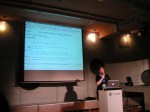
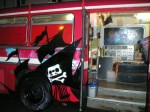

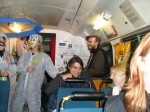
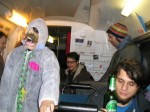
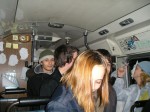
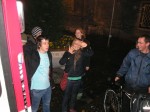
I think that all data should be divisible into FIRE, WIND, EARTH, and WATER. There are detractors who insist that HEART be included in this taxonomy, but I say those people are full of crap.
Look, HEART may be the wussiest of the elements, but how else are you going to classify data about making animals like you.
Glitch-art and the in-between manifesto (“neither fish nor fowl”) are lauding fresh perspectives and open-mindedness, which can be fruitful prods to creativity. That’s one reason there’s so much action in interdisciplinary fields. The concept has a long history. By the way, a chalk line (tool) could also serve as a garrote (weapon).